| (insert your NIE or newspaper logo here) | Weekly Online LessonOnline Lesson ArchiveGrade Level: 6-9
|
A Visit to Vietnam
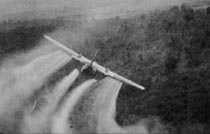 The war in Vietnam has been over for 30 years, but decisions made
by the United States and other governments during the conflict still
haunt thousands of Americans and Vietnamese today.
The war in Vietnam has been over for 30 years, but decisions made
by the United States and other governments during the conflict still
haunt thousands of Americans and Vietnamese today.
The decision to use the toxic chemical called Agent Orange, for example, has been linked to birth defects, cancer and other illnesses among those living in Vietnam and neighboring regions. American soldiers were exposed to Agent Orange while stationed there, and many of them have also developed serious health problems.
From 1962 until 1971, about 20 million gallons of Agent Orange and other herbicides were sprayed over 30,000 square miles across Vietnam, Cambodia, and Laos. Their purpose was to defoliate the region's thick jungles and expose enemy forces.
While the chemicals did defoliate the forests, they also ended up in drinking water and farmlands, leaving a legacy of environmental and health problems.
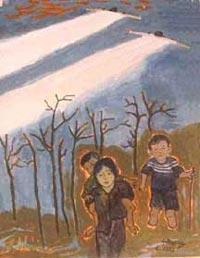 On behalf of millions of Vietnamese, a civil lawsuit was recently
filed against the American chemical companies that supplied Agent Orange.
On behalf of millions of Vietnamese, a civil lawsuit was recently
filed against the American chemical companies that supplied Agent Orange.
The suit seeks billions of dollars in damages and the environmental cleanup of Vietnam. The suit claims that because Agent Orange contains dioxin, its use amounted to poisoning the region's residents, making it a war crime.
But the federal court judge ruled on Thursday, March 10, 2005, that the chemical companies could not be held responsible for the damages done. Supplying the toxic chemicals doesn't qualify as a war crime, he said, because the agents weren't specifically used to poison the people -- that was just a side effect of its primary use as an herbicide.
The plaintiffs intend to appeal the case to the U.S. Supreme Court.
Clearly, the military conflict of the 1960s affected Vietnam's people and its government in a major way. But that war is just one event in the region's 2,000-year history that has had a hand in shaping local customs and cultures.
For this week's lesson, you'll get a deeper look at Vietnam -- exploring its geography, rich history, mix of people, and various cultural traditions.
Exploring Vietnam
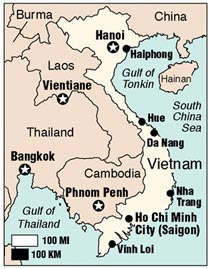 To begin our journey, let's start at the ThinkQuest site, Vietnam:
Then & Now.
To begin our journey, let's start at the ThinkQuest site, Vietnam:
Then & Now.
Read the Introduction, then jump to the Geography section.
(Note: To look at more detailed maps than this website includes, visit the Perry-Castañeda Library Map Collection at the University of Texas.)
Read that introduction then browse the pages that explain the region's Geography, Climate, Flora and Fauna, and Tourism.
Why do the climates vary between the northern, central, and southern regions? Where are the major rivers located? Where are the cities of Hanoi and Ho Chi Minh City? In what ways are Vietnam's variable geography, climate, flora, fauna, and tourism opportunities linked?
Now, let's take a look at Vietnam's History.
Read the introduction, then browse through The Beginning, the Au Lac Dynasty, and the Trieu Dynasty.
What are the names of the two major races? What technological developments shaped the region's economy and communities during the Au Lac Dynasty? How did the Trieu Dynasty lead to Chinese Domination? Who were the Trung sisters?
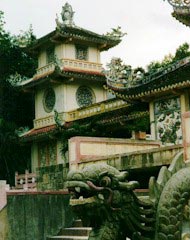 Next, check out what happened during the Ngo,
Dinh,
Tien Le, Ly,
Tran,
Ho, Le,
and Nguyen
dynasties.
Next, check out what happened during the Ngo,
Dinh,
Tien Le, Ly,
Tran,
Ho, Le,
and Nguyen
dynasties.
How did relationships between the Vietnamese and Chinese change over the years? In what ways did the region's rulers influence political, social, and economic developments? What other factors shaped these developments?
The consequences of French Intervention were also key in the evolution of Vietnamese politics and culture. Why was the country split in half?
Next, discover what events led to the Vietnam War involving the United States. Why was the U.S. concerned about China's influence?
What was the Tet Offensive and how did it affect American involvement? How exactly did the War Conclude? What happened in the Aftermath, for both Americans and Vietnamese?
These political forces had major impacts on the composition, cultures, and People of this region, as you'll soon discover by getting a closer view of the People, Cultures, Celebrations, Customs, Food, Lifestyles, Recreation, and Religion.
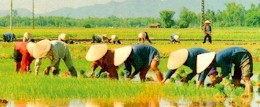 What
role do family ties play in daily life and customs? In what ways do
different areas of the country differ? How have the Vietnamese integrated
"outside" influences, related to social and religious beliefs,
architecture, art, etc., while maintaining a unique identity?
What
role do family ties play in daily life and customs? In what ways do
different areas of the country differ? How have the Vietnamese integrated
"outside" influences, related to social and religious beliefs,
architecture, art, etc., while maintaining a unique identity?
Lastly at this site, let's get a handle on Vietnam's Government. After reading the introduction, find out a little more about the Government structure, and how it affects the nation's Economy and Education system.
In what ways does the Vietnamese government differ from that of the U.S.? How did the Vietnamese government's economic policies change over time? When must Vietnamese families begin paying for their children's education?
Journeys of Body, Mind & Spirit
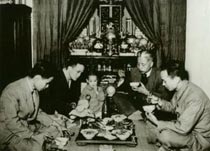 Now
that you've gotten a good sense of how the Vietnamese culture evolved,
let's explore their cultures even more deeply -- through Journeys
of Body, Mind & Spirit at the American Museum of Natural
History.
Now
that you've gotten a good sense of how the Vietnamese culture evolved,
let's explore their cultures even more deeply -- through Journeys
of Body, Mind & Spirit at the American Museum of Natural
History.
Begin with the Introduction, then journey through the site using the Next button at the bottom of each page. As you go, click on thumbnail images to look at larger photos and watch the movie clips (RealPlayer required).
In Journeys through Time and Space, you'll get a brief summary of Vietnam Today, along with the History of the People.
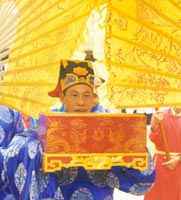 Continue
through the Journeys
of Gods, Family and Ancestors and Journeys
of People and Goods.
Continue
through the Journeys
of Gods, Family and Ancestors and Journeys
of People and Goods.
Why is Tet such an important celebration, and how does it involve family ties? How are ceramics and integral part of both traditional customs and economic stability? In what ways do varying local cultures drive trade and tourism?
Let's move on, exploring Journeys of Life and Death, Journeys of Heroes and Deities, and Journeys to Other Worlds, and Journeys through the Year.
How has the nation's history, along with regional religious beliefs, influenced the creation of ritualistic celebrations and customs? In what ways are the beliefs in and celebration of heroes and deities important to Vietnamese society? Why are some people considered gods? What exactly do shamans do?
Newspaper Activities
Watch for articles in The Salt Lake Tribune related to Vietnam, including news about the nation's government, legal action against American chemical companies, Vietnamese culture or families. If any articles feature herbicide-related illnesses, what are some of the challenges the Vietnamese face in addressing these health concerns? What kind of relationship does Vietnam have with various governments, including the United States, China, France, Cambodia, and Laos? Can you find any stories that feature local Vietnamese families? If so, why are they being featured? Are they contributing art to the local community or participating in an international food festival, for example?
© Copyright 2005
Learners
Online, Inc.
